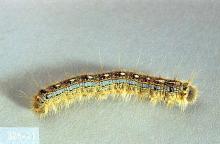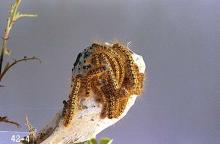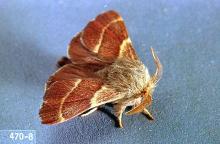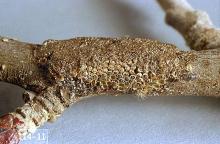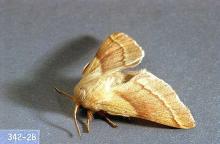Includes
Forest tent caterpillar (Malacosoma disstria)
Western tent caterpillar (Malacosoma californicum)
Pest description and crop damage The western tent caterpillar and the forest tent caterpillar are the main tent caterpillar pests in the PNW. These insects attack a wide variety of plants, including alder, ash, birch, cottonwood, and willow, as well as fruit trees and roses. The adult moths are stout-bodied, light to darker brown, and are active in early to midsummer. They are attracted to lights at night.
Larvae of the forest tent caterpillar are about 2 inches long, blue, with black spattered markings as well as white, footprint-shape marks. Larvae of the western tent caterpillar are hairy, dull yellow-brown, with rows of blue and orange spots on the body. Eggs of these moths are laid on twigs or buildings in masses. These are brown to gray, about 0.06 inch long, and look like polystyrene.
Larvae of both species feed in large groups on the foliage of host plants and can do significant damage by defoliation. Larvae of the western tent caterpillars build large silken tents over leaves on which they feed. Larvae of the forest tent caterpillars build mats of webbing rather than tents. Larvae can completely defoliate small trees, which may not kill them, but reduces growth and makes the trees more susceptible to diseases. Healthy trees usually grow new leaves by midsummer.
Biology and life history The moths overwinter as egg masses on twigs or buildings. Eggs hatch in spring as buds break in April or May. The young larvae feed in groups for 5 to 6 weeks, growing larger and molting (shedding skins) four times. As they mature, they split into smaller groups and move to new feeding sites in the tree. The larvae pupate starting in mid-June, and the adults emerge 7 to 10 days later. The adults moths mate and females lay eggs that overwinter. There is one generation per year.
Pest monitoring Look for egg masses on twigs or other overwintering sites. Masses of young larvae are identified easily in early spring.
Management-biological control
Infestations of tent caterpillars occur cyclically as populations of the caterpillars and their predators rise and fall. Tent caterpillars have many natural enemies. Some birds eat the caterpillars and small mammals consume the pupae. The larvae of a tachinid fly parasitize the caterpillars.
Management-cultural control
Remove egg masses from twigs or other sites. Cut out infested twigs and dip them in a bucket of soapy water.
Management-chemical control: HOME USE
Spray in spring after overwintering eggs hatch, at about the time leaves are 0.75 to 1 inch long. Control is much more effective if sprays are applied when larvae are small.
- azadirachtin (neem oil)-Some formulations are OMRI-listed for organic use.
- Bacillus thuringiensis var. kurstaki-Some formulations are OMRI-listed for organic use.
- esfenvalerate
- gamma cyhalothrin
- lambda-cyhalothrin (often as a mix with other ingredients)
- plant-derived essential oils (e.g., canola oil, peppermint oil, rosemary oil)-Some formulations are OMRI-listed for organic use and have shown efficacy against spider mites.
- pyrethrins (often as a mix with other ingredients)-Some formulations are OMRI-listed for organic use.
- spinosad- Some formulations are OMRI-listed for organic use
- zeta-cypermethrin
Management-chemical control: COMMERCIAL USE
- azadirachtin + pyrethrins (Azera) at 2 pints/A. OMRI-listed for organic use. PHI 1 day. REI 12 hr.
- Bacillus thuringiensis var. kurstaki-See label for rates. PHI 0 days. Follow label instructions. Add a spreader-sticker to enhance control. Some formulations are OMRI-listed for organic use.
- methoxyfenozide (Intrepid 2F, generics) at 0.12 to 0.25 lb ai/A. PHI 14 days. REI 4 hr. Do not exceed 24 fl oz/A per application or 64 fl oz/A (1 lb ai/A) per season. Do not apply within 25 ft of an aquatic habitat, 150 ft if applied by air.
- pyrethrins 5% (PyGanic, Lynx) at 15 to 17 oz/A. No residual activity. PyGanic OMRI-listed for organic use. PHI 1 day. REI 12 hr.
- methoxyfenozide (Misc.) at 15 to 17 oz/A. No residual activity. PyGanic OMRI-listed for organic use. PHI 1 day. REI 12 hr.


